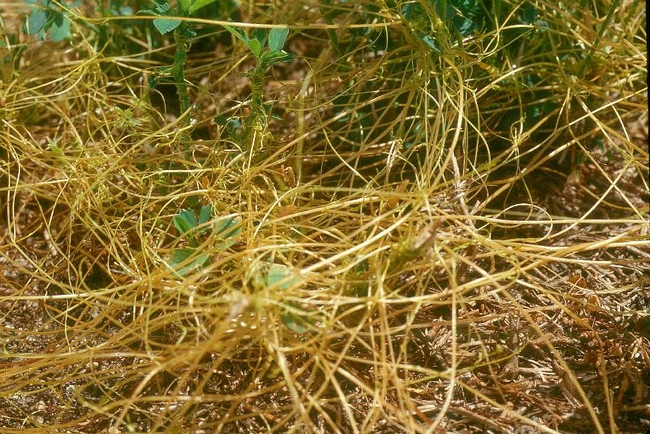From the Alfalfa & Forage News blog :: Feb. 18, 2013
Dodder is a troublesome annual parasitic weed that infests alfalfa fields. Initial infestations are usually caused by sowing dodder infested seed (a good reason to purchase Certified seed) and by “sheeping off” fields with sheep that came from an infested field. Perhaps no weed problem is worse than an alfalfa field heavily infested with dodder. As a parasite, it lives at the expense of the alfalfa plant and literally sucks the vigor and life out of the plant. If left uncontrolled it can actually kill the alfalfa plant. It emerges as a rootless shoot and must attach itself to a suitable host within a few days or it dies. After it embeds its sucker-like structures (called haustoria) into the alfalfa stem, it sends out additional shoots which attach to adjacent alfalfa stems and plants. It can form large dense colonies often several feet in diameter.
Historically, dodder control has been an almost insurmountable challenge to alfalfa producers. Most growers relied primarily on post emergence flaming or spot treatment with dinoseb (no longer registered or available) but control was typically only partial and the grower was usually frustrated with the results. These days there are more tools available to growers, greatly improving dodder control in the field. The introduction of preemergence dinitroaniline herbicides, Treflan (trifluralin) granules and later registration of Prowl H2O (pendimethalin), markedly improved the ability of growers to control dodder.
While dodder is a summer annual weed and is typically not even observed until early summer, now is the time to treat with Treflan or Prowl. The preemergence dinitroaniline herbicides must be incorporated by rainfall or irrigation prior to dodder emergence to be effective. Initial dodder emergence can be as early as early March in the San Joaquin Valley. So apply Prowl or Treflan for dodder control now to be assured the herbicide is applied and incorporated with adequate rainfall (ideally ½”) prior to dodder emergence.
The key to effective dodder control is not to allow any seed production. Therefore, any plants that escape a preemergence herbicide application should be controlled before they flower (beginning in June through August) and set seed by spot treating with Pursuit (imazethapyr) or by flaming. Pursuit used postemergence between cuttings has been found to suppress attached dodder. Decades ago, Dr. Jean Dawson conducted studies that showed extremely low rates of Roundup (glyphosate) can be used to selectively kill dodder without injuring alfalfa. However, the margin of safety was too narrow and the control was too erratic for this to be a widely adopted practice. However, now with the advent of RR alfalfa, growers can use Roundup to effectively control dodder without injuring the alfalfa. Depending on the infestation level and the timing of treatment, a sequential application of Roundup might be needed rather than a single application for complete control. However, using this tool nearly 100 percent dodder control is feasible.
The key with any dodder control program is to be painstakingly persistent and not allow any plants to flower and reseed the field. By using a preemergence control program followed by spot treatment of escapes or an effective program using glyphosate and RR alfalfa, dodder can now be effectively eliminated and is no longer the dreadful pest it once was.
